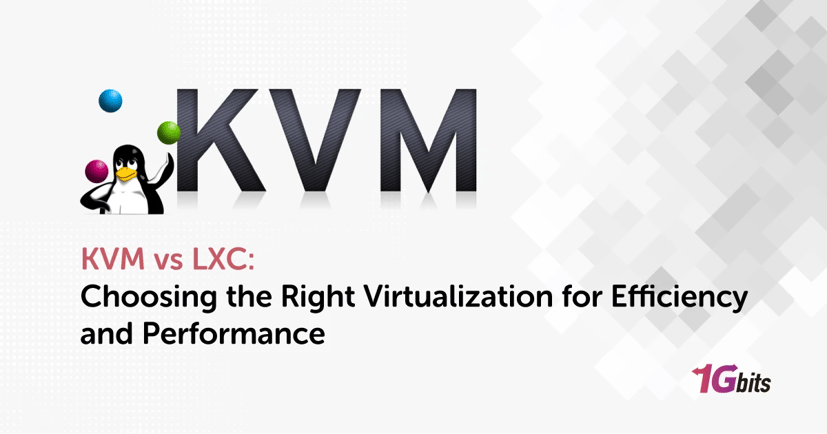When it comes to containerization and virtualization, the debate of KVM vs LXC is a common one among IT professionals and enthusiasts. Both technologies offer unique advantages and cater to different use cases, making it crucial to understand their strengths and limitations. KVM (Kernel-based Virtual Machine) is a robust full virtualization solution integrated into the Linux kernel, providing each virtual machine with isolated hardware resources. On the other hand, LXC (Linux Containers) operates at the OS-level, sharing the host system’s kernel, which allows for lightweight and efficient containerized applications.
In this comprehensive comparison, we will delve into KVM vs LXC, exploring various aspects such as proxmox lxc vs vm performance, lxc vs kvm security, and use cases. We will also touch upon Proxmox KVM vs LXC, analyzing how these technologies integrate within the Proxmox VE environment. Additionally, we will assess KVM vs LXC performance metrics, examining the efficiency and overhead associated with each. Security is another crucial factor; thus, we will contrast LXC vs KVM in terms of isolation and vulnerability management. Finally, our discussion will include LXC vs KVM performance and the practical implications for different virtualization and containerization scenarios. Join us as we navigate the intricacies of KVM LXC, providing a clear perspective on which technology might best suit your needs.
What is kvm?
KVM (Kernel-based Virtual Machine) is an open-source virtualization technology integrated into the Linux kernel. It transforms the Linux kernel into a hypervisor, allowing it to run multiple virtual machines (VMs) with their own isolated operating systems and hardware resources. This technology leverages hardware-assisted virtualization features, such as Intel VT-x and AMD-V, to efficiently manage and execute VMs.
KVM provides full virtualization, meaning that each VM operates independently with a dedicated set of virtual hardware. This isolation ensures that one VM's activities do not interfere with another, enhancing stability and security. KVM supports a wide range of guest operating systems, including various distributions of Linux, Windows, BSD, and others, making it a versatile solution for different virtualization needs.
The architecture of KVM is relatively simple. It consists of a loadable kernel module, kvm.ko, that provides the core virtualization infrastructure and processor-specific modules, such as kvm-intel.ko or kvm-amd.ko, for handling Intel and AMD processors, respectively. In addition to these, a user-space component called QEMU (Quick Emulator) works in tandem with KVM to provide I/O device emulation and other functionalities, enabling the creation and management of virtual machines.
One of the key advantages of KVM is its deep integration with the Linux ecosystem. This integration allows KVM to benefit from the robust features and security measures inherent to the Linux kernel. Furthermore, KVM supports live migration, which enables the seamless transfer of running VMs from one physical host to another with minimal downtime, making it suitable for maintaining high availability in enterprise environments.
Comparing KVM vs LXC reveals some distinct differences. While KVM provides full virtualization, LXC (Linux Containers) offers operating-system-level virtualization, where containers share the host's kernel but run isolated processes. This fundamental distinction has significant implications for performance and resource utilization.
LXC containers are lightweight and efficient because they do not require a separate operating system for each instance, as VMs do. This efficiency often translates to better LXC vs KVM performance for scenarios that involve running multiple instances of similar applications. However, because LXC containers share the host's kernel, they may be less secure than KVM VMs, which offer stronger isolation.
The debate of KVM vs LXC often extends to specific use cases, such as LXC Docker and Proxmox LXC. Docker, a popular containerization platform, builds on LXC technology to provide a streamlined and user-friendly experience for creating and managing containers. On the other hand, Proxmox, a powerful virtualization management solution, supports both KVM and LXC, enabling users to choose the best technology for their needs. Proxmox LXC is particularly useful for scenarios where lightweight, efficient containers are preferred over fully isolated virtual machines.
In terms of LXC vs KVM performance, the choice depends on the specific workload and requirements. For applications that require high security and complete isolation, KVM may be the better option. In contrast, for tasks that demand high efficiency and low overhead, LXC containers might be more suitable.
Security is another critical factor in the KVM vs LXC debate. KVM's full virtualization provides stronger isolation between VMs, reducing the risk of one compromised VM affecting others. LXC containers, while offering excellent performance, share the host's kernel, which can pose security challenges if not properly managed.
In conclusion, KVM is a robust and versatile virtualization technology that provides full virtualization through the Linux kernel. The KVM vs LXC comparison highlights the strengths and trade-offs of each approach. KVM offers strong isolation and supports a wide range of operating systems, making it suitable for diverse virtualization needs. In contrast, LXC containers excel in performance and efficiency, particularly when running multiple instances of similar applications. Whether to use KVM or LXC depends on specific use cases, performance requirements, and security considerations.
What is lxc?
LXC (Linux Containers) is an operating-system-level virtualization technology that allows multiple isolated Linux systems (containers) to run on a single host. Unlike traditional virtualization technologies, which involve running separate operating systems on virtual machines, LXC containers share the host's kernel but operate in isolated environments. This sharing of the kernel makes LXC containers lightweight and efficient, as they do not require the overhead of separate operating systems for each instance.
Namespaces provide isolation for various system resources, including process IDs, network interfaces, and file systems. This isolation ensures that processes inside a container do not interfere with those outside or in other containers. Cgroups allow for fine-grained resource allocation, limiting the amount of CPU, memory, and I/O that each container can use. Seccomp adds an additional layer of security by restricting the system calls that containers can make, reducing the attack surface.
When comparing KVM vs LXC, several key differences emerge. KVM (Kernel-based Virtual Machine) provides full virtualization, meaning each VM runs its own kernel and operating system. This approach offers strong isolation between VMs, making it suitable for scenarios that require high security and support for multiple operating systems. However, this comes with a higher overhead compared to LXC, as each VM needs its own OS and associated resources.
On the other hand, LXC containers share the host's kernel, leading to much lower overhead. This makes LXC ideal for running multiple instances of similar applications, as containers can start and stop quickly and use fewer resources. The efficiency of LXC often results in better performance compared to traditional VMs in certain scenarios. This is particularly evident in environments that require rapid scaling and high density of instances.
Another critical aspect of the KVM vs LXC debate is performance. LXC containers typically offer superior performance due to their lightweight nature and minimal overhead. This is especially true for scenarios that involve running multiple instances of the same application, where the shared kernel and efficient resource usage of LXC shine. However, KVM’s full virtualization is advantageous for applications that need complete isolation and compatibility with a variety of operating systems.
In the context of LXC, security is also an important consideration. While LXC containers are generally secure, they share the host's kernel, which can pose risks if a container is compromised. Properly configuring namespaces, cgroups, and seccomp is crucial to maintaining container security. In contrast, KVM VMs are more isolated, providing an additional layer of security.
In conclusion, LXC is a powerful and efficient containerization technology that leverages the Linux kernel's capabilities to provide isolated environments for applications. The KVM vs LXC comparison highlights the strengths and trade-offs of each approach. LXC containers excel in performance and efficiency, making them ideal for high-density, rapidly scaling environments. Meanwhile, KVM offers strong isolation and support for multiple operating systems, suitable for use cases requiring robust security and diverse OS support. Whether to use KVM or LXC depends on specific requirements, including performance, security, and the nature of the applications being deployed.
Why should you use kvm?
When deciding on a virtualization solution, the debate of KVM vs LXC often comes up. KVM (Kernel-based Virtual Machine) is a powerful technology that enables full virtualization, where each virtual machine (VM) runs its own operating system and is isolated from others. Understanding the reasons to use KVM can help you make an informed decision in the KVM vs LXC comparison.
Full Virtualization and Isolation
One of the primary reasons to use KVM is its full virtualization capability. Unlike LXC (Linux Containers), which uses operating-system-level virtualization, KVM allows each VM to run its own independent kernel. This level of isolation is crucial for applications requiring high security and stability, as it ensures that each VM operates in a completely separate environment. In the KVM vs LXC comparison, this makes KVM ideal for hosting diverse operating systems and applications that need strong isolation.
Broad Operating System Support
KVM supports a wide range of guest operating systems, including various distributions of Linux, Windows, BSD, and more. This versatility is a significant advantage in the KVM vs LXC debate, especially for environments that need to run multiple operating systems simultaneously. LXC, in contrast, is limited to running Linux-based containers since they share the host’s kernel.
Performance and Efficiency
While LXC containers are known for their efficiency, KVM also offers impressive performance thanks to hardware-assisted virtualization features like Intel VT-x and AMD-V. These features allow KVM to run VMs with near-native performance, making it suitable for performance-intensive applications. In the context of KVM vs LXC performance, KVM's ability to leverage hardware acceleration gives it a competitive edge for workloads that require high computational power.
Security
Security is a critical factor in choosing between KVM vs LXC. KVM's full virtualization provides robust security by isolating VMs at the hardware level. Each VM has its own kernel, reducing the risk of cross-VM attacks. This strong isolation is particularly important for environments handling sensitive data or running untrusted applications. While LXC containers can be secure, they inherently share the host's kernel, which can pose additional security challenges.
Live Migration
KVM supports live migration, a feature that allows running VMs to be moved from one physical host to another with minimal downtime. This capability is essential for maintaining high availability and load balancing in enterprise environments. In the KVM vs LXC comparison, live migration is a significant advantage for KVM, as it enhances flexibility and resilience in virtualized infrastructures.
Integration with Management Tools
KVM integrates seamlessly with various management tools and platforms, such as Proxmox VE, OpenStack, and oVirt. These tools provide comprehensive solutions for managing virtualized environments, offering features like automated deployment, resource management, and monitoring. In the context of Proxmox KVM vs LXC, for instance, KVM's integration with Proxmox VE enables users to leverage advanced management capabilities while benefiting from KVM's robust virtualization features.
Scalability
KVM's architecture allows for excellent scalability. It can efficiently manage a large number of VMs, making it suitable for both small-scale deployments and large enterprise environments. In the KVM vs LXC debate, KVM's ability to scale effectively is a crucial consideration for growing businesses that need to expand their virtualized infrastructure without compromising performance or security.
Choosing between KVM vs LXC depends on your specific requirements. KVM offers full virtualization, broad operating system support, high performance, robust security, live migration, seamless integration with management tools, and excellent scalability. These features make KVM a compelling choice for environments that need strong isolation, diverse OS support, and enterprise-level capabilities. While LXC containers provide efficiency and rapid scaling, KVM's comprehensive advantages make it the preferred option for many virtualization scenarios.
Why should use lxc?
When considering virtualization and containerization technologies, the discussion of KVM vs LXC is a frequent one. LXC (Linux Containers) offers a different approach compared to traditional virtualization solutions like KVM (Kernel-based Virtual Machine). Understanding the reasons to use LXC can help you make an informed decision in the KVM vs LXC debate. This section-by-section explanation outlines the benefits of using LXC.
Lightweight and Efficient
One of the primary advantages of LXC is its lightweight nature. Unlike KVM, which involves running full virtual machines with separate operating systems, LXC containers share the host’s kernel. This shared kernel approach reduces overhead, making LXC containers more efficient in terms of resource utilization. In the KVM vs LXC comparison, LXC’s efficiency allows for higher density deployments, meaning more containers can run on the same hardware compared to virtual machines.
Rapid Deployment and Scaling
LXC containers can be deployed and started much faster than KVM virtual machines. This speed is particularly beneficial in environments where rapid scaling is necessary, such as microservices architectures or development environments. The ability to quickly spin up and tear down containers gives LXC a distinct advantage in scenarios where agility and speed are crucial. In the KVM vs LXC performance context, LXC’s rapid deployment capabilities make it an attractive choice for dynamic workloads.
Simplified Resource Management
LXC provides simplified resource management through its use of cgroups (control groups) and namespaces. Cgroups allow administrators to allocate resources like CPU, memory, and I/O bandwidth to specific containers, ensuring efficient utilization and preventing any single container from monopolizing resources. Namespaces provide isolation for processes, network interfaces, and file systems, ensuring containers operate independently. In the KVM vs LXC debate, this streamlined resource management is a significant benefit of using LXC.
Consistent Environment
LXC containers offer a consistent environment across different stages of development, testing, and production. Because containers package applications with their dependencies, they ensure that the application runs the same way in different environments. This consistency is particularly useful for DevOps practices, where maintaining uniformity across the development pipeline is essential. In the KVM vs LXC comparison, LXC’s ability to provide a consistent environment makes it ideal for modern software development workflows.
Security Through Isolation
While LXC containers share the host’s kernel, they still provide a level of security through namespaces and cgroups. These features isolate containers from each other, preventing interference and enhancing security. Although KVM offers stronger isolation due to its full virtualization, LXC’s isolation mechanisms are sufficient for many use cases, especially when combined with additional security measures. In the context of LXC vs KVM, LXC strikes a balance between efficiency and security, making it suitable for many applications.
Integration with Orchestration Tools
LXC integrates well with container orchestration tools like Kubernetes and Docker. These tools provide powerful capabilities for managing containerized applications, including automated deployment, scaling, and monitoring. This integration enhances LXC’s utility in cloud-native environments and microservices architectures. In the KVM vs LXC debate, LXC’s compatibility with orchestration tools gives it an edge for modern, containerized application deployment.
Flexibility and Versatility
LXC containers are versatile and can be used for a wide range of applications, from lightweight development environments to production workloads. Their flexibility makes them suitable for different scenarios, including continuous integration and continuous deployment (CI/CD) pipelines, testing environments, and even some production applications. In the KVM vs LXC comparison, LXC’s versatility is a key advantage, allowing it to adapt to various needs and use cases.
Choosing between KVM vs LXC depends on specific requirements and use cases. LXC offers lightweight and efficient containerization, rapid deployment, simplified resource management, consistent environments, adequate security through isolation, integration with orchestration tools, and flexibility. These benefits make LXC an excellent choice for environments that prioritize efficiency, speed, and modern application deployment practices. While KVM provides robust isolation and broad operating system support, LXC’s strengths make it a compelling option for many scenarios in the evolving landscape of IT infrastructure.
Which is better: kvm vs lxc?
The debate of KVM vs LXC often arises when choosing a virtualization or containerization solution. Both KVM (Kernel-based Virtual Machine) and LXC (Linux Containers) offer unique advantages, making it essential to understand their differences and strengths. This section-by-section explanation will compare KVM vs LXC across various criteria to help determine which is better for different scenarios.
Architecture and Isolation
KVM provides full virtualization by allowing each virtual machine (VM) to run its own independent operating system and kernel. This strong isolation ensures that VMs are securely separated, which is particularly useful for running diverse and potentially untrusted workloads. In contrast, LXC uses operating-system-level virtualization, where containers share the host's kernel but run in isolated environments. This makes LXC more lightweight and efficient, as containers do not require separate operating systems. In the KVM vs LXC comparison, KVM offers stronger isolation, while LXC excels in efficiency. To compare KVM and Xen, see KVM vs Xen article.
Performance and Resource Utilization
LXC containers are known for their high performance and efficient resource utilization. Since containers share the host’s kernel, they have less overhead compared to VMs, allowing for higher density deployments and faster start-up times. This makes LXC ideal for applications that need rapid scaling and high efficiency. On the other hand, KVM, with hardware-assisted virtualization features like Intel VT-x and AMD-V, provides near-native performance for VMs. While KVM might have more overhead than LXC, its performance is still robust for demanding workloads. In terms of KVM vs LXC performance, LXC has the edge for lightweight applications, whereas KVM is better suited for resource-intensive tasks.
Flexibility and Use Cases
KVM is highly versatile, supporting a wide range of operating systems, including various Linux distributions, Windows, and BSD. This broad OS support makes KVM suitable for environments that need to run multiple types of operating systems simultaneously. LXC, however, is limited to running Linux-based containers, which can be a restriction if non-Linux environments are needed. In the KVM vs LXC comparison, KVM offers more flexibility in terms of OS support, while LXC is better for Linux-centric deployments. For a comparison of KVM and Hyper-V see the KVM vs Hyper-V article.
Security
Security is a crucial factor in choosing between KVM vs LXC. KVM provides strong isolation at the hardware level, reducing the risk of cross-VM attacks. This makes it suitable for applications that handle sensitive data or require high security. LXC containers, while isolated through namespaces and cgroups, share the host’s kernel, which can pose additional security challenges. Properly configuring security measures can mitigate these risks, but KVM inherently offers stronger isolation. In the KVM vs LXC debate, KVM is generally considered more secure due to its full virtualization approach.
Integration and Ecosystem
Both KVM and LXC integrate well with various management and orchestration tools. KVM is supported by platforms like Proxmox VE, OpenStack, and oVirt, providing comprehensive solutions for managing virtualized environments. LXC integrates seamlessly with container orchestration tools like Kubernetes and Docker, making it ideal for cloud-native and microservices architectures. In the context of Proxmox KVM vs LXC, Proxmox VE supports both technologies, allowing users to choose based on their specific needs. In the KVM vs LXC comparison, both have robust ecosystems, but their integration focus differs based on the type of deployment.
Deployment and Scalability
LXC containers offer rapid deployment and scaling capabilities, making them suitable for dynamic environments that require frequent changes and fast provisioning. Their lightweight nature allows for quick startup and shutdown, which is beneficial for continuous integration/continuous deployment (CI/CD) pipelines and development environments. KVM, while not as fast to deploy as LXC, offers excellent scalability and can manage a large number of VMs efficiently. In the KVM vs LXC debate, LXC is preferable for rapid scaling and development, whereas KVM is better for stable, large-scale production environments.
Determining which is better, KVM vs LXC, depends on specific use cases and requirements. KVM offers full virtualization, robust isolation, broad OS support, and strong security, making it ideal for diverse, resource-intensive, and high-security applications. LXC, on the other hand, provides lightweight, efficient, and rapidly deployable containers, making it perfect for Linux-centric, cloud-native, and dynamic environments. In the KVM vs LXC comparison, both technologies have their strengths, and the choice ultimately depends on the specific needs of the deployment.
Conclusion
In the KVM vs LXC debate, choosing the better technology depends on specific needs and use cases. KVM offers robust isolation, full virtualization, and broad OS support, making it ideal for diverse, high-security, and resource-intensive applications. Its strong security and ability to handle different operating systems make KVM a versatile choice for many scenarios. Conversely, LXC shines with its lightweight, efficient, and rapidly deployable containers, making it perfect for Linux-centric, cloud-native, and dynamic environments. LXC’s efficiency and quick start-up times are advantageous for rapid scaling and development purposes. Ultimately, in the KVM vs LXC comparison, both have distinct advantages: KVM is suited for environments requiring strong isolation and OS diversity, while LXC excels in performance and efficiency for Linux-based applications. The decision in the KVM vs LXC debate should be guided by the specific requirements and goals of your virtualization or containerization strategy.











